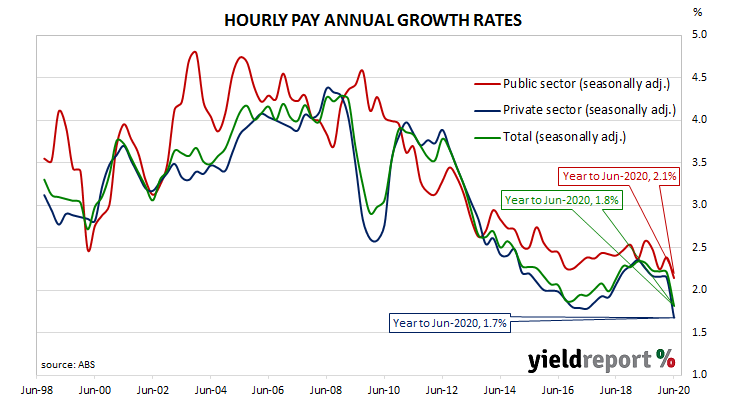Summary: June quarter wage growth down significantly; annual growth rate back below 2%; public sector wage increases partially offset private sector; “informal sector” bears brunt, offsets increases from enterprise agreement and award-based jobs, ABS underutilisation rate points to continued slowdown; “smaller or partially-deferred minimum wage rises, wage freezes, wage cuts” expected.
After unemployment increased and wage growth slowed during the GFC, a resources investment boom prompted a temporary recovery back to nearly 4% per annum. However, from mid-2013 through to the September quarter of 2016, the pace of wage increases slowed, until mid-2017 when it began to slowly creep upwards. The figures from the December and March quarters were suggestive of a decreasing growth rate; the latest report has continued this trend but at an accelerated rate.
According to the latest wage price index (WPI) figures published by the Australian Bureau of Statistics (ABS), hourly wages grew by just 0.2% in the June quarter. The increase was less than the 0.3% which had been generally expected and lower than the 0.5% which had been recorded in each of the previous three quarters. The year-on-year growth rate slipped from the March quarter’s revised rate of 2.2% to 1.8%.
Westpac senior economist Justin Smirk said, “The pressure of the COVID shock to activity is unprecedented and has seen rapid shift in private sector wages.” He noted public sector increases had helped “hold wage inflation positive in the quarter…”

The report came out on the same day as the latest Westpac-Melbourne institute consumer sentiment report. Local Treasury bond yields increased noticeably at the long end, largely in line with higher US Treasury yields in overnight trading. By the end of the day, the 3-year ACGB yield had added 1bp to 0.31%, the 10-year yield had gained 5bps to 0.94% while the 20-year finished 6bps higher at 1.51%.
In the cash futures market, expectations of a change in the actual cash rate remained fairly stable. By the end of the day, contracts implied the cash rate would remain in a range of 0.12% to 0.13% through to the latter part of 2021.
Hourly wage growth in the public sector has been generally faster than in the private sector since late 2013. There have been just a few quarters over this time period in which the difference has been in favour of the private sector but, again, the June quarter was not one of them. Wages in the private sector grew by 0.1% while wages in the public sector grew by 0.6%. Over the past 12 months, wages in the private sector increased by 1.7% while public sector wages grew by 2.2%. Annual wage growth in the two sectors had been at 2.1% and 2.4% respectively in the March quarter.

